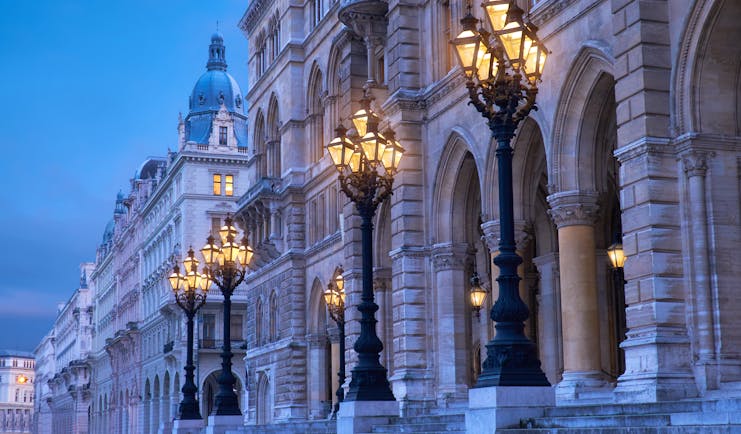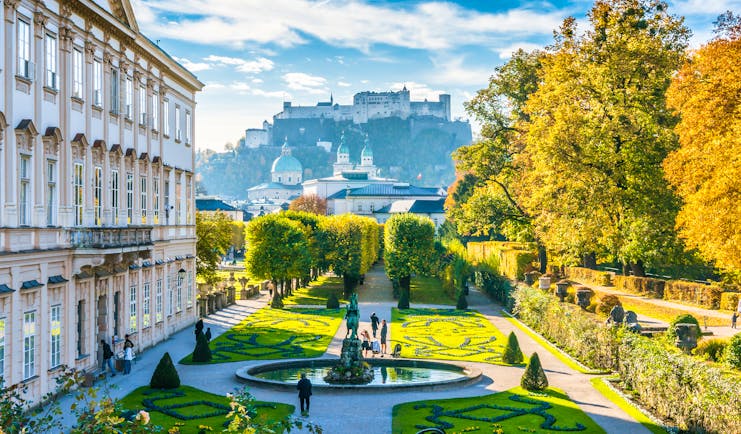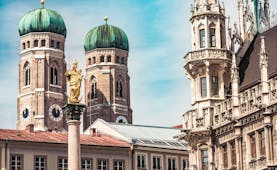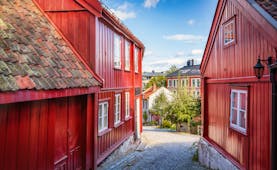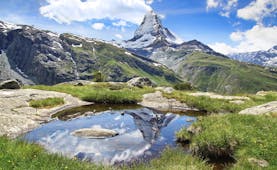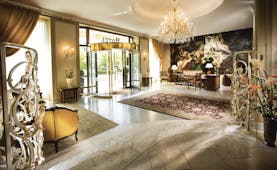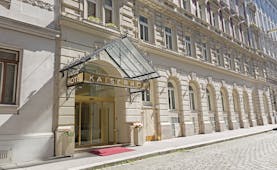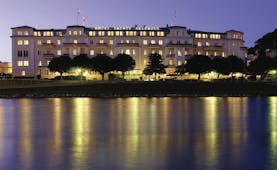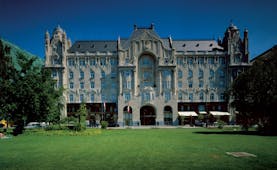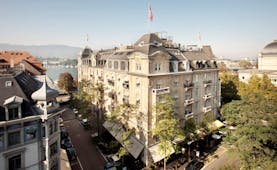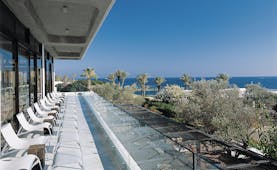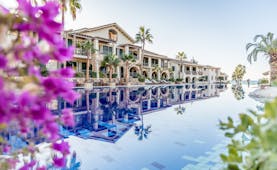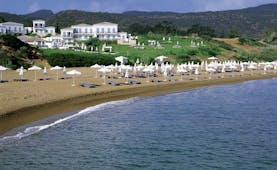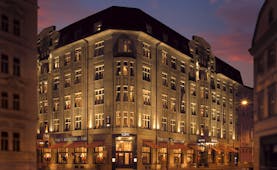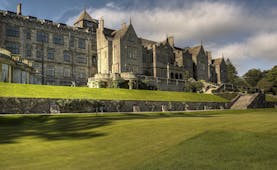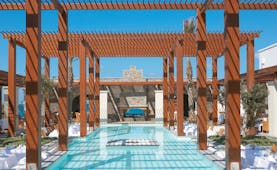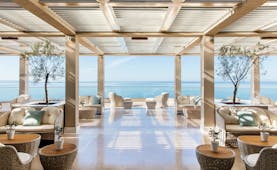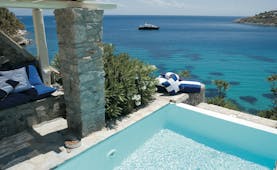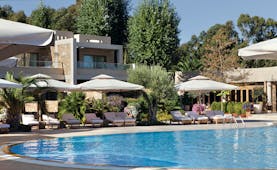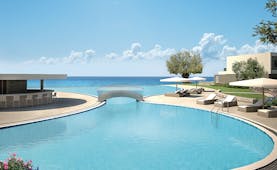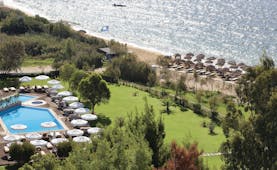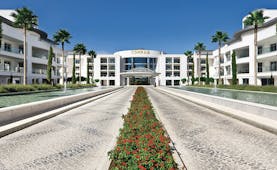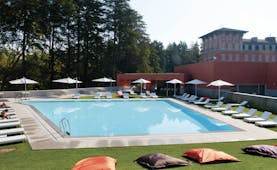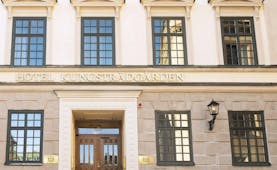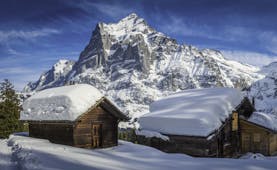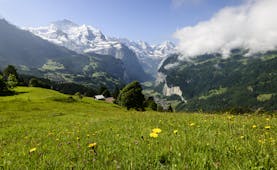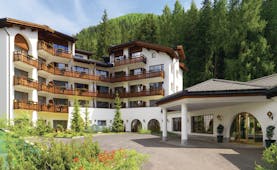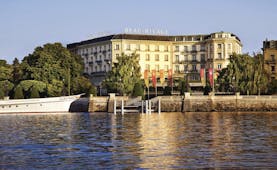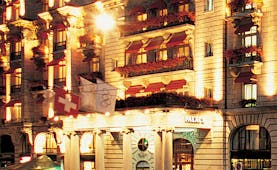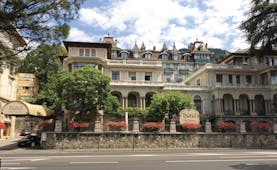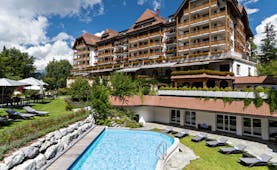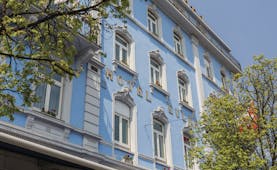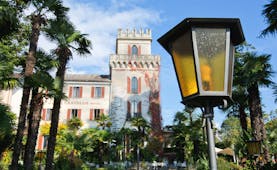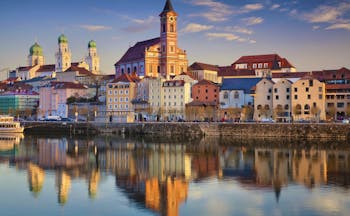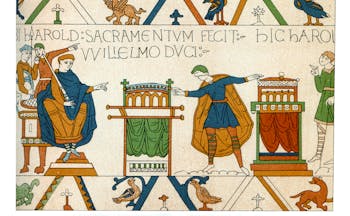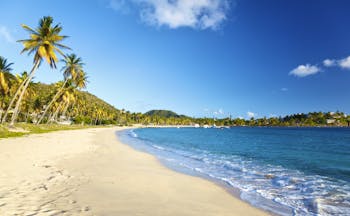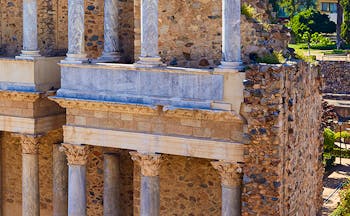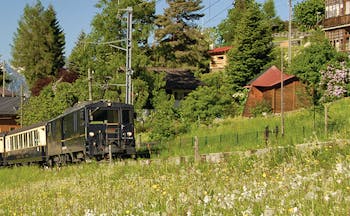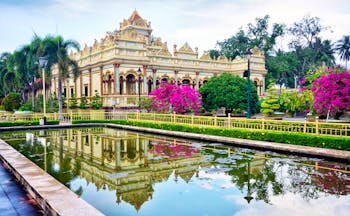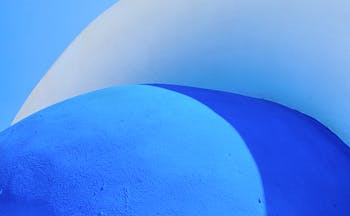Luxury touring holiday by train to the majestic cities of Austria and Budapest along the Arlberg and returning via Munich
This 11-night rail touring holiday begins with your arrival in Zurich, either by rail or air. After a night here, you will travel by rail to Innsbruck through the dramatic Arlberg Pass. As the cars disappear into the road tunnel below, the train continues to climb, ducking in and out of tunnels for the last part of the climb, until you emerge at St Anton. After the descent into the Inn valley, it is definitely the Austrian Tirol: traditional haystacks, onion-domed churches, wayside chapels. After experiencing one night in the capital of the Tyrol, Innsbruck, with its associations with Emperor Maximilian I and modern-day summer and winter sports. The rail journey continues to Salzburg, the birthplace of Mozart, home to magnificent Baroque churches, imposing castles and elegant palaces. Your third Austrian city is the great city of Vienna, on the banks of the River Danube and at the heart of central European history since the Roman times. Vienna never fails to impress and satisfy the visitor eager for historical and cultural references. ‘Dream and reality’ still resonate and your days in Vienna can be filled with a mixture of galleries, museums, opera, concerts or eating and drinking in a ‘Heuriger’ in the Vienna Woods. The history of Vienna can be witnessed in the Roman Museum, the Neidhart frescoes dating from the 1400s, the mediaeval Basiliskenhaus, the Imperial Palace and the numerous Jugendstil buildings, and of course in the City of Vienna museum. From Vienna, you travel eastwards tracking the course of the River Danube to the city of Budapest. Budapest is a fascinating mixture of two settlements: Buda and Pest, dissected by the Danube. On the hill in Buda, there is the 13th Century Matthias Church and the neo-Gothic and neo-Romanesque Fishermen’s Bastion. Linking Buda to Pest is the magnificent Chain Bridge built in the mid-19th Century. Pest is a city of wide boulevards, parks and gardens, neo-Gothic buildings such as the Parliament containing the Hungarian Crown Jewels, and the two-mile-long Andrassy út, lined with important buildings including the State Opera House and the Museum of Fine Arts. Budapest is also home to the largest medicinal baths in Europe. At the end of your holiday, fly back to the UK or travel back by rail. If you opt to travel by rail, we suggest getting a direct service from Budapest to Munich and spending one night there before travelling home the following day.
Highlights
Zurich • Arlberg Pass • Innsbruck • Salzburg • Vienna • Budapest • Munich
Day by day
Begin your holiday by travelling to Zurich by rail. Catch the Eurostar mid-morning to Paris. After changing stations in Paris, catch a direct train from Paris to Zurich arriving in the evening. Stay in Zurich for one night.
After breakfast at your hotel in Zurich, travel by train to Innsbruck. The journey will take around 3 hours 30 minutes and offers spectacular scenery. First the train hugs the southern shore of Lake Zurich, and its bathing places and little harbours with the Gold Coast gleaming on the other side of the lake. Then comes the Walensee with its turquoise waters and deep cliffs dropping into the lake. The landscape opens up as you approach the eastern edge of Switzerland, where Liechtenstein perches and the borders of Austria and Switzerland meet south of Lake Constance. The high mountains, the roof of Europe, loom in the distance. You sense them more than you see them. Suddenly with Feldkirch you are in Austria and after Bludenz the train climbs up along the Arlberg. As the cars disappear into the road tunnel below, the train continues to climb, ducking in and out of tunnels for the last part of the climb, until you emerge at St Anton. After the descent into the Inn valley, it is definitely the Austrian Tirol: traditional haystacks, onion-domed churches, wayside chapels. From the Oetztal station, you know the road heads south to Obergurgl and the Timmelsjoch high Alpine road into Italy. The train continues along the Inn valley, passing lush pastureland and Tirolean villages, including that of Stams, famous for its monastery. The Olympic ski jump at Igls to the right of the train indicates the imminent arrival in Innsbruck. Arrive in Innsbruck in the afternoon. You have the rest of the day and the evening to explore the city and its array of architectural gems from the Gothic, Renaissance, Baroque and Neo-Classical period.
Enjoy breakfast at your hotel and board a direct train to Salzburg where you will arrive in under two hours. As you leave Innsbruck, ski slopes are visible in the distance, and you know that Kitzbuehel is off to the south-east but at Kufstein the train crosses into Germany and the landscape flattens slightly with fields and forests yet the Chiemgau Alps are in the near distance. The train travels to the south of the Chiemsee and then Austria approaches once more. There is a spectacular although fleeting moment as the train crosses the river Salzach and on the right you are dazzled by the spires and turrets of the old city of Salzburg and Festung Salzburg on the hill-top on the horizon. Check in to your hotel for a stay of two nights.
You have a full day in Salzburg to discover this compact and very attractive city. Famous for being the birthplace of Mozart and the location for “The Sound of Music”, there are also numerous gardens and intricate architecture to enjoy, notably striking Baroque churches and buildings designed by Fischer von Erlach. The often piercing green-grey waters of the Salzach River flow through the city centre and the old town is on the left bank where you can find the Hohensalzburg Fortress, an 11th century castle which sits upon the Festungsberg. Other places of interest include the Mirabell Palace Gardens – a UNESCO World Heritage Site - and Mozart’s birthplace, a museum which tells the compelling story of his life, relationships and musical inspirations. Today, the Salzburg Festival in July and August each year, offers an array of opera, music and drama.
After a leisurely breakfast in Salzburg, board a direct rail service to Vienna, where you will arrive in under 2 and a half hours. After Salzburg, the countryside becomes a patchwork of arable fields and large farmhouses before the more built-up stretch between Wels and Linz. It is at Linz you meet the Danube and then you cross from Upper Austria into Lower Austria, leaving the trail of the Danube to meander further north, cutting its own gorge above the Wienerwald before it reaches Vienna. You may not see it at all during your stay in Vienna. Check into your hotel in Vienna for three nights.
You have two full days to explore Vienna at leisure. Vienna, on the banks of the River Danube, has been at the heart of central European history since the Roman times. Vienna never fails to impress and satisfy the visitor eager for historical and cultural references. ‘Dream and reality’ still resonate and your days in Vienna can be filled with a mixture of galleries, museums, opera, concerts or eating and drinking in a ‘Heuriger’ in the Vienna Woods. The history of Vienna can be witnessed in the Roman Museum, the Neidhart frescoes dating from the 1400s, the mediaeval Basiliskenhaus, the Imperial Palace and the numerous Jugendstil buildings, and of course in the City of Vienna museum. The Hofburg contains numerous national collections from the Crown Jewels to the Imperial armoury. Your second day in Vienna may be the best opportunity to explore the city’s inextricaple relationship with music. Take time to listen to the Mozart Orchestra playing in the Musikverein, and to enjoy coffee and cake at Demel’s. A fun way to see the sights of the city is to take a tram around the Ringstrasse, hopping off and on as you want.
Leave Vienna mid-morning to continue your rail holiday to Budapest. The journey takes under 3 hours, following the course of the River Danube. You arrive in the afternoon and check into your hotel for three nights.
Enjoy two full days in Budapest exploring the tree-lined boulevards of Pest and the cobbled hilly streets of Buda. The city straddles a curve in the River Danube and is packed with interesting sights to visit on foot but also easily reached by underground. Visit the Castle District in Buda where you can find mediaeval buildings such as the Royal Palace which has been rebuilt several times over the past seven centuries and houses the National Gallery, Budapest Historical Museum and the Museum of Contemporary Art. You can also visit the 13th Century St Matthias Church and the neo-Gothic Fishermen’s Bastion nearby. The world-famous Gellért Thermal Baths are highly favoured by locals and tourists alike. Margaret Island is a pretty park situated in the middle of the Danube reachable by tram or bus. It boasts more than 10,000 trees, beautiful gardens and a swimming pool. Linking Buda to Pest is the magnificent Chain Bridge built in the mid-19th Century. On your second day in Budapest you may wish to explore the area 0east of the river, where you will find Pest. This district is home to historical buildings such as the neo-Gothic, vast, Parliament which houses the Hungarian crown jewels. Another building not to miss is the Hungarian State Opera House where you can experience a guided tour or an opera performance. On two-mile long, tree-lined Andrassy út you will find elegant shops and houses, Heroes Square and the Museum of Fine Arts. The thermal springs of Budapest have been enjoyed since Roman times and baths are to be found in both Buda and in Pest, where the Szechenyi Baths are one of the largest bathing complexes in Europe, with outdoor and indoor pools, built in modern Renaissance style.
After breakfast in Budapest, board the Railjet train in the morning and you will arrive in Munich less than seven hours later. The route takes you back through Vienna, on to Linz and Salzburg. Watch out for the Salzburg fortress on your left-hand side as you cross the River Salzach shortly after departing from Salzburg station. Stay overnight in Munich. Or, if you prefer, fly back to London from Budapest.
Enjoy a full German breakfast at your hotel before you check out and begin your journey back to London. You will take a train from Munich to Brussels with an easy change of trains in Frankfurt before boarding the Eurostar to London St Pancras.
My daughter and I had a fabulous time on our holiday. The hotels were all spectacular in their different ways, the train journeys were exciting and gorgeous scenery and the organisation from the various rail networks was spot on.Mrs B, June 2022
Holiday price guide From about £2,480 per person based on two people sharing a double room and including for second class rail travel. First class and standard premier on Eurostar supplement about £580 per person.
Holiday Code EEBR03
Call us on 01392 441245
Luxury touring holiday by train to the majestic cities of Austria and Budapest along the Arlberg and returning via Munich
Begin your holiday by travelling to Zurich by rail. Catch the Eurostar mid-morning to Paris. After changing stations in Paris, catch a direct train from Paris to Zurich arriving in the evening. Stay in Zurich for one night.
After breakfast at your hotel in Zurich, travel by train to Innsbruck. The journey will take around 3 hours 30 minutes and offers spectacular scenery. First the train hugs the southern shore of Lake Zurich, and its bathing places and little harbours with the Gold Coast gleaming on the other side of the lake. Then comes the Walensee with its turquoise waters and deep cliffs dropping into the lake. The landscape opens up as you approach the eastern edge of Switzerland, where Liechtenstein perches and the borders of Austria and Switzerland meet south of Lake Constance. The high mountains, the roof of Europe, loom in the distance. You sense them more than you see them. Suddenly with Feldkirch you are in Austria and after Bludenz the train climbs up along the Arlberg. As the cars disappear into the road tunnel below, the train continues to climb, ducking in and out of tunnels for the last part of the climb, until you emerge at St Anton. After the descent into the Inn valley, it is definitely the Austrian Tirol: traditional haystacks, onion-domed churches, wayside chapels. From the Oetztal station, you know the road heads south to Obergurgl and the Timmelsjoch high Alpine road into Italy. The train continues along the Inn valley, passing lush pastureland and Tirolean villages, including that of Stams, famous for its monastery. The Olympic ski jump at Igls to the right of the train indicates the imminent arrival in Innsbruck. Arrive in Innsbruck in the afternoon. You have the rest of the day and the evening to explore the city and its array of architectural gems from the Gothic, Renaissance, Baroque and Neo-Classical period.
Enjoy breakfast at your hotel and board a direct train to Salzburg where you will arrive in under two hours. As you leave Innsbruck, ski slopes are visible in the distance, and you know that Kitzbuehel is off to the south-east but at Kufstein the train crosses into Germany and the landscape flattens slightly with fields and forests yet the Chiemgau Alps are in the near distance. The train travels to the south of the Chiemsee and then Austria approaches once more. There is a spectacular although fleeting moment as the train crosses the river Salzach and on the right you are dazzled by the spires and turrets of the old city of Salzburg and Festung Salzburg on the hill-top on the horizon. Check in to your hotel for a stay of two nights.
You have a full day in Salzburg to discover this compact and very attractive city. Famous for being the birthplace of Mozart and the location for “The Sound of Music”, there are also numerous gardens and intricate architecture to enjoy, notably striking Baroque churches and buildings designed by Fischer von Erlach. The often piercing green-grey waters of the Salzach River flow through the city centre and the old town is on the left bank where you can find the Hohensalzburg Fortress, an 11th century castle which sits upon the Festungsberg. Other places of interest include the Mirabell Palace Gardens – a UNESCO World Heritage Site - and Mozart’s birthplace, a museum which tells the compelling story of his life, relationships and musical inspirations. Today, the Salzburg Festival in July and August each year, offers an array of opera, music and drama.
After a leisurely breakfast in Salzburg, board a direct rail service to Vienna, where you will arrive in under 2 and a half hours. After Salzburg, the countryside becomes a patchwork of arable fields and large farmhouses before the more built-up stretch between Wels and Linz. It is at Linz you meet the Danube and then you cross from Upper Austria into Lower Austria, leaving the trail of the Danube to meander further north, cutting its own gorge above the Wienerwald before it reaches Vienna. You may not see it at all during your stay in Vienna. Check into your hotel in Vienna for three nights.
You have two full days to explore Vienna at leisure. Vienna, on the banks of the River Danube, has been at the heart of central European history since the Roman times. Vienna never fails to impress and satisfy the visitor eager for historical and cultural references. ‘Dream and reality’ still resonate and your days in Vienna can be filled with a mixture of galleries, museums, opera, concerts or eating and drinking in a ‘Heuriger’ in the Vienna Woods. The history of Vienna can be witnessed in the Roman Museum, the Neidhart frescoes dating from the 1400s, the mediaeval Basiliskenhaus, the Imperial Palace and the numerous Jugendstil buildings, and of course in the City of Vienna museum. The Hofburg contains numerous national collections from the Crown Jewels to the Imperial armoury. Your second day in Vienna may be the best opportunity to explore the city’s inextricaple relationship with music. Take time to listen to the Mozart Orchestra playing in the Musikverein, and to enjoy coffee and cake at Demel’s. A fun way to see the sights of the city is to take a tram around the Ringstrasse, hopping off and on as you want.
Leave Vienna mid-morning to continue your rail holiday to Budapest. The journey takes under 3 hours, following the course of the River Danube. You arrive in the afternoon and check into your hotel for three nights.
Enjoy two full days in Budapest exploring the tree-lined boulevards of Pest and the cobbled hilly streets of Buda. The city straddles a curve in the River Danube and is packed with interesting sights to visit on foot but also easily reached by underground. Visit the Castle District in Buda where you can find mediaeval buildings such as the Royal Palace which has been rebuilt several times over the past seven centuries and houses the National Gallery, Budapest Historical Museum and the Museum of Contemporary Art. You can also visit the 13th Century St Matthias Church and the neo-Gothic Fishermen’s Bastion nearby. The world-famous Gellért Thermal Baths are highly favoured by locals and tourists alike. Margaret Island is a pretty park situated in the middle of the Danube reachable by tram or bus. It boasts more than 10,000 trees, beautiful gardens and a swimming pool. Linking Buda to Pest is the magnificent Chain Bridge built in the mid-19th Century. On your second day in Budapest you may wish to explore the area 0east of the river, where you will find Pest. This district is home to historical buildings such as the neo-Gothic, vast, Parliament which houses the Hungarian crown jewels. Another building not to miss is the Hungarian State Opera House where you can experience a guided tour or an opera performance. On two-mile long, tree-lined Andrassy út you will find elegant shops and houses, Heroes Square and the Museum of Fine Arts. The thermal springs of Budapest have been enjoyed since Roman times and baths are to be found in both Buda and in Pest, where the Szechenyi Baths are one of the largest bathing complexes in Europe, with outdoor and indoor pools, built in modern Renaissance style.
After breakfast in Budapest, board the Railjet train in the morning and you will arrive in Munich less than seven hours later. The route takes you back through Vienna, on to Linz and Salzburg. Watch out for the Salzburg fortress on your left-hand side as you cross the River Salzach shortly after departing from Salzburg station. Stay overnight in Munich. Or, if you prefer, fly back to London from Budapest.
Enjoy a full German breakfast at your hotel before you check out and begin your journey back to London. You will take a train from Munich to Brussels with an easy change of trains in Frankfurt before boarding the Eurostar to London St Pancras.
My daughter and I had a fabulous time on our holiday. The hotels were all spectacular in their different ways, the train journeys were exciting and gorgeous scenery and the organisation from the various rail networks was spot on.Mrs B, June 2022
Holiday price guide From about £2,480 per person based on two people sharing a double room and including for second class rail travel. First class and standard premier on Eurostar supplement about £580 per person.
Holiday Code EEBR03
Our prices include
● Day-time rail travel from London to Zurich and throughout the tour, returning by train from Munich via Brussels
● First or second-class travel on all trains
● 1 night’s bed and breakfast in a Classic double room at the Hotel St Gotthard, Zurich
● 1 night’s bed and breakfast in a Classic double room at the Hotel Schwarzer Adler, Innsbruck
● 2 nights’ bed and breakfast in a Double room at the Hotel Goldgasse, Salzburg
● 3 nights’ bed and breakfast in a Classic double room at the Hotel Kaiserhof, Vienna
● 3 nights’ bed and breakfast in a Deluxe double room at the Prestige Hotel, Budapest
● 1 night’s bed and breakfast in a Standard double room at the Hotel Torbrau, Munich
● Concierge service and Expressions Holidays regional helpful hints
Our prices do not include
● Early check-in or late check-out at any hotels (although we can arrange this on request at additional cost)
● Any other services not mentioned above, such as transfers and meals except breakfast at hotels
● Personal holiday insurance. This is essential and cover should be in place from when you book the holiday.
● Local tourist tax, usually between Euros/Swiss Francs/Hungarian forints 1 and 3 per person per night, and payable locally to the hotel
● Transfers
● By air with scheduled flights from the UK to Zurich and returning from Budapest or Munich to the UK, with rail travel from Zurich to Budapest or Munich
Call us on 01392 441245
Luxury touring holiday by train to the majestic cities of Austria and Budapest along the Arlberg and returning via Munich

Hotel St Gotthard is a sophisticated 4-star hotel in an excellent central location. Haute cuisine and stylish, comfortable accommodation make this an excellent spot to recuperate after enjoying the cultural delights of Zurich.
Classic double

The Romantik Hotel Europe in Zurich is a charming, boutique, family-run hotel with 39 rooms just two minutes’ walk from the shores of Lake Zurich and by the Opera House.
Classic double

Hotel Storchen is an elegant and refined 5-star boutique hotel in a beautiful waterfront location. Delicious cuisine and luxurious accommodation make this an excellent spot to recuperate after enjoying the cultural and historical delights of Zurich.
Classic double

Hotel Schwarzer Adler is a cosy and characterful 4-star boutique hotel, housed in a historic building in the centre of Innsbruck. Delicious local cuisine and luxurious wellness facilities make it an idyllic retreat in a beautiful Alpine location.
Classic double room

The Hotel Goldgasse is a boutique hotel with a modern design, nestled in the centre of Salzburg’s Old Town.
Classic double room

Hotel Kaiserhof Vienna is a four-star hotel in an excellent central location not far from the Karlsplatz. The atmosphere is charming and welcoming, and it is furnished in a traditional way in keeping with the historic building of the hotel.
Classic double room

The 5-star Hotel Bristol Vienna is the ultimate in Austrian luxury. Opulent interiors, gourmet cuisine and stunning views of the city and Vienna State Opera House makes this a memorable stay in the heart of the Austrian capital.
Classic double room
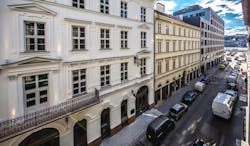
Prestige Hotel Budapest is a 4-star deluxe hotel which blends timeless elegance and contemporary touches in a central location. Michelin-star dining and supremely comfortable, opulent accommodation make it an excellent retreat from the bustle of Budapest.
Deluxe double room

Hotel Torbräu is a good-quality, comfortable four-star hotel in an excellent location. Modern, chic interiors and a choice of excellent dining facilities make it an ideal spot to recuperate after enjoying the delights of Munich.
Standard double room
My daughter and I had a fabulous time on our holiday. The hotels were all spectacular in their different ways, the train journeys were exciting and gorgeous scenery and the organisation from the various rail networks was spot on.Mrs B, June 2022
Holiday price guide From about £2,480 per person based on two people sharing a double room and including for second class rail travel. First class and standard premier on Eurostar supplement about £580 per person.
Holiday Code EEBR03
Call us on 01392 441245
Luxury touring holiday by train to the majestic cities of Austria and Budapest along the Arlberg and returning via Munich
About Austria
An Expressions tailor-made holiday to Austria gives travellers the chance to explore and experience this historic and diversely beautiful country. Crowned by the fading imperial glories of Vienna, with central Europe beckoning out along the Danube to the east, and a stunning, chocolate-box Alpine hinterland to the west, Austria is an unbeatable Mitteleuropa beauty. Throughout its eventful history, Austria has retained a penchant for indulgence, opulent aestheticism, and the cultivation of the higher pleasures in life. Visible in the rolling green pastures that cover the lands between the Alps, and in the grand architecture of the cities, this side to Austria still prevails. Inhabited since the Palaeolithic Age, Austria holds a wealth of dramatic and dynamic history within its fertile valleys. Former seat of the Habsburgs, the Austrian capital of Vienna is strewn with architectural riches. Provincial capitals Linz and Graz are now large, cultural towns with vast open squares, beautifully lit fountains, and hilltop castles, but they still retain their cobbled town centres. Salzburg, the birthplace of Mozart, is smattered with stunning baroque churches, and has an Alpine backdrop straight out of the Sound of Music. The wide turquoise River Salzach separates the modern buildings of recently-built Salzburg from the peaked roofs of the older parts of town, which circle the hill on which the stunning Hohensalzburg Castle is perched. Small boats disappear down the river into the lush green valley beyond, where wooden chalet-style houses climb the riverbanks. With ground-breaking cultural figures peppering Austria's history - Freud, Mozart, Strauss, Schubert, and Klimt, to name but a few - the country is awash with important galleries, concert halls, museums, and opera houses. In fact, you won't need to go in search of culture, in Austria it all but waltzes straight up to you. Coupled with spectacular Gothic churches and baroque cathedrals, this makes Austria a fascinating country to explore, with beautiful old coffee houses and cafes almost every step of the way. Beyond the towns, the Tyrol is a hiker's Promised Land, Innsbruck is the radiant, ethereal winter capital, with an array of ski resorts just a step away, and charming old stone village guest-houses. In summer, cowbells tinkle in flower-filled meadows, gluhwein is forever warming over the fire, and whole holidays can be spent just exploring the lakes, forests, summits, and valleys, without setting foot in a bustling, lively town.
Highlights of Austria
The idyllic pathways along the Danube set the scene for romantic afternoon or evening walks, passing either the city or the hilly green countryside dotted with old castles. Seek out the wine estates and cellars of Grinzing, in order to sample some of the best of Austrian produce in a location beyond compare across Europe. The beautiful, cobbled old town of Innsbruck will introduce you to the indescribable atmosphere of the quaint smaller towns of Austria, and act as your gateway into the untamed, rugged landscape of the Alps. The Bregenz Forest forms one of the main regions in Vorarlberg, and is home to the idyllic villages, tinkling cow bells, and alpine dairies that have become both iconic for the region and synonymous with Austria. The Grossglockner Road is a fantastic 30-mile drive that extends through epic glacial mountain scenery, climbing more than 8,000ft to Austria's highest peak, Mount Grossglockner. The phenomena at Krimml Falls include Europe's highest waterfall, which crashes down from mossy green cliffs over jagged brown rocks. For more of Austria's surprising natural beauty, visit the salt mine and ice caves of Hallstatt, a town of simplistic quaint churches and wooden-panelled houses that cling to the banks of the Hallstatter See. Head back into another of Austria's beautiful cities to see the baroque splendours of Salzburg, before climbing the hill of the Hohensalzburg Castle, the city's crowning glory. Krems an der Donau is a charming university town filled with Heuringen, or traditional wine taverns that seem to blend the iconic Italian love of wine with the rustic, homely establishments of the Alpine countries. The hip town of Linz is full of contemporary architecture, including the gravity-defying Voest Steelworks, which points out towards the undulating horizon. Austria's second city, Graz, has a lovely medieval centre with a buzzing cultural scene. Finally, on every stay in Austria, we would recommend soaking up the peace and serenity available at each of our Austrian hotels; the same peace and serenity that continually makes Austria such a fulfilling holiday destination.
Cultural highlights of Austria
Perhaps begin by exploring Vienna's handsome Gothic churches and the baroque cathedral, which look out over the atmospheric, cobbled streets, the most beautiful of which are situated around the University area of Schottentor. Then stop-off for lunch or a light afternoon snack in one of Vienna's coffee houses, or take one of the trams, straight out of the Third Man, which are a wonderfully romantic way to get about town. Admire the vast imperial facade of Schonbrunn Palace, former seat of the Habsburg Empire, and soak up the sunshine beside the Neptune Fountain in the palace gardens, with the charming arches of the Gloriette as your backdrop. For a taste of the city's intellectual culture, visit the Freud museum or the Kunsthistorisches museum, which houses several paintings by Gustav Klimt. Moving and memorable performances can be watched at Vienna's Spanish Riding School and the Boys’ Choir.
Facts in brief
Capital ViennaAirport Vienna is the main transport hub for Austria, but Graz, Linz, Klagenfurt, Salzburg and Innsbruck all receive international flights.
Size 32,000 sq. miles
Population 8 million
Call us on 01392 441245
Luxury touring holiday by train to the majestic cities of Austria and Budapest along the Arlberg and returning via Munich
About Germany
An Expressions tailor-made holiday to Germany enables travellers to experience a fascinating and richly varied country. Germany is replete with regional quirks and personalities - a strong feature of German life and a hangover from the days, not too long ago, when the country was once a patchwork of independent states. Today, to travel from the ancient ports of the north, across the open fields of the German plain, and down through the Ruhr and onto the forests, mountains and cosmopolitan cities of Germany’s Bavarian south, you’ll experience an intriguing variety as great – and appealing – as you’d find anywhere else in Europe. Several of Germany’s cities have the air of national capitals. Cologne, though enmeshed in one of Europe’s most intensively industrialised regions, is rich in monuments. Bavaria’s capital, Munich, is another star attraction, with great museums and galleries. Berlin, the nucleus of the turmoil of reunification, is now one of the most sophisticated, artistic and exciting cities on the planet, while Nuremberg is thrillingly ancient, with the most charming of winter markets in the 11th century square, and summer festivals when the cobbled streets come alive with street artists and musicians. Scattered between these city big-hitters, quieter, utterly charming cities and large towns abound, with medieval old towns straight out of fairy-tale picture books. Heidelberg, the oldest university town in Germany, is an absolute gem, nestling between wooded hills on the banks of the Neckar river, a setting that has seduced visitors ever since the days of the Grand Tour. But from Trier to Bamberg, Marburg to Meissen, Regensburg to Rothenburg, enchanting old towns abound. Beyond Germany’s beautiful cities and towns, the Bavarian Alps, right on Munich’s doorstep, are a spectacular playground for hikers and bikers, horse-riders and skiers. The Rhine and Mosel are both littered with castles and vineyards, offering an enchanting backdrop for the cruise boats that drift serenely along their waters. And stretching more than 100 miles north to south, and 45 miles from east to west, the Black Forest is awash with pretty spa towns and exquisite health resorts, crisscrossed with walking trails. The Black Forest also boasts some of the most spectacular rail journals on the planet. A beautiful, intriguing country vastly at odds with its stiff stereotype, Germany is a wonderful holiday destination for active outdoorsy types and city-breakers alike.
Highlights of Germany
Berlin’s world-class museums, bustling bars, galleries and monuments; Rugen Island, with its rugged chalk cliffs, windswept beaches, Romantic-era spa architecture and tree-lined country roads; Dresden, with its baroque beauty on the banks of the majestic Elbe; Cologne’s magnificent cathedral; the UNESCO World Heritage city of Bamberg; the sandy dunes of Sylt, a North Sea island with fabulous beaches and surf; the beer halls of Munich, ideally in September during the Oktoberfest; Lubeck, a Hanseatic gem; Muritz National Park, where you can go paddling and camping in a paradise teeming with birds; Bremen, a metropolis in miniature, with lovely red-brick and Art Nouveau architecture; the Alpine resorts of Bavaria, including Berchtesgaden, with dramatic peaks, dreamy lakes and superb walking trails; drive or cruise along the Rhine or Mosel, visiting castles, medieval villages and superb vineyards along the way; the walled medieval towns of Rothenburg and Trier, both with wonderful Christmas markets; the Christmas market at Nuremberg, oldest – and still most picturesque – in the world.
Facts in brief
Capital BerlinAirport Several airports are served from the UK, including Berlin, Bremen, Cologne-Bonn, Dortmund, Dresden, Dusseldorf, Frankfurt, Hamburg, Hannover, Stuttgart and Munich.
Size 137,000 sq. miles
Population 82 million
Call us on 01392 441245
Luxury touring holiday by train to the majestic cities of Austria and Budapest along the Arlberg and returning via Munich
About Hungary
An Expressions tailor-made holiday to Hungary entices travellers as a country like no other, with a unique language and culture transplanted from Central Asia more than a thousand years ago. Situated right at the heart of Europe, and often mistakenly classified as one of the Balkan countries alongside neighbours Romania, Serbia and Croatia, Hungary boasts a spectacular setting on the banks of the Danube and an enchanting Mitteleuropa vibe – coffee houses and Turkish baths, Habsburg splendours and baroque architecture. Budapest naturally attracts the bulk of visitors to Hungary. With Budapest’s spectacular buildings and hotels, few ever venture beyond the city, except perhaps for a day trip on the Danube Bend. Richly rewarded as they will be, ignoring Hungary’s other towns and regions is a huge mistake: the farmland of the Southern Plain, the beautiful, vineyard-covered Villany Hills in Transdanubia, the forested Northern Uplands bordering Ukraine, the historic town of Sopron so enticingly close to Vienna, the Turkish-flavoured town of Pecs, and the resorts of Lake Balaton – Hungary is a fantastic country to explore, standing at the crossroads of East and West.
Highlights of Hungary
Budapest, with its coffee houses and thermal baths, as well of course as its wonderful cobbled Old Town, and the mansions, palace and sheer grandiosity of Castle Hill; Sopron one of the most charming medieval cities in Europe, and a gateway to the stunning Lover Hills; Esztergom, seat of Roman Catholicism in Hungary, and site of the country’s most important basilica; Visegrad, with its hilltop medieval castle overlooking the Danube Bend; the baroque architecture and wine cellars of Eger; Hortobagy, a tiny village at the heart of Hungary’s puszta, the country’s original Wild West; the Great Plains cultural capital of Szeged, full of Art Nouveau masterpieces; the vineyards of Villany; Pecs, with its Turkish feel and fabulous museums and mosques, galleries and Roman tombs; Lake Balaton, full of water sports resorts; Heviz, Europe’s largest thermal lake; Sumeg, home to one of Hungary’s most imposing castles; Danube river cruises; Veszprem, with its perfectly preserved castle district.
Travel around Hungary
Public transport is well developed in Hungary, with efficient bus and, in many cities and towns, trolleybus services. Budapest, Szeged, Miskolc and Debrecen also have trams, and there's a three-line metro (underground or subway) system and a suburban railway known as the HÉV in the capital. Hungary's bus network is a good - and sometimes necessary - alternative to the trains, with train travel on the Great Plain in Southern Transdanubia normally involving several time-consuming changes.
Facts in brief
Capital BudapestAirport Ferihegy International Airport in Budapest
Size 35,000 sq. miles
Population 9.7 million
Call us on 01392 441245
Luxury touring holiday by train to the majestic cities of Austria and Budapest along the Arlberg and returning via Munich
About Zurich
Zurich is a city that adapts to and flourishes in every season. In the summer, it is a cosmopolitan haven of designer boutiques, riverside pavement cafes, 50 museums, and over 100 galleries; and, in the winter, the streets of grand townhouses, churches, and palaces are transformed into a veritable winter wonderland. Step outside the city and you are immediately cast back into rural, Alpine Switzerland as the landscape becomes more dramatic and Lake Zurich dominates the plethora of natural interest sites. Towns such as Winterthur and Uster are home to their own range of traditions and their own character, with architecture and cuisine that reflects both the proximity of the German border and a proud Swiss national identity. With such close proximity to Zurich airport and the major railway lines, Zurich is an excellent first or last stop on a touring holiday.
Highlights of Zurich
The capital of the German-speaking canton of Zurich is the internationally-renowned historic city of Zurich. The perfect place to acclimatise to the Swiss way of life, there is much cultural discovery to be done. Perhaps begin with the waters of Lake Zurich and the River Limmat, taking a scenic boat cruise, or hiring a dingy for a more hands-on approach. Pedal boats offer a happy medium, and the lakefront Badi-Bars are beautifully situated for an evening drink afterwards. To witness the beauty of the city from above, climb to the top of the Karlsturm, one of the Grossmunster Church's two iconic towers. On the banks of the River Limmat is Schipfe, Zurich's oldest district. It was once the headquarters of the silk industry, and home to many tranquil bathhouses and the workshops of boat-builders; now, however, it has a very serene atmosphere that attracts artisans as well as visitors looking for peaceful strolls down quaint streets. The Lindenhof District was the site of a Roman fort in the 4th century, and Charlemagne's grandson's palace in the 9th century. Today, it is a popular meeting place for Zurich's residents. For a sweeping view of Zurich's Old Town, walk along the promenade in the Niederdorf District. Here, shops are hidden down narrow alleyways, old-fashioned grocery stores sell the local produce, and the views of grand stone buildings are topped off by the Grossmunster's towers. Everywhere in Zurich, however, there are pockets of outstanding beauty, be it beside the 1,200 fountains of drinkable water, on the historic Little Red Train, or Polybahn, that takes you up to the Polyterrasse, or on the world's most luxurious shopping mile, the Bahnhofstrasse.
Cultural highlights of Zurich
Informative cultural experiences can be had at a number of locations around the city. The Kunsthaus Art Museum exhibits a range of permanent and temporary displays by artists of international and local acclaim. The Museum Rietberg exhibits a range of non-European artistic and cult objects. The Arthouse Cinemas are known throughout Europe for the rare opportunity they provide to view independent films in a cinema setting. For innovative modern art, visit the Migros Museum or the Kunsthalle at Lauenbrau-Areal. More unique artistic ventures can be found at the Bruno Weber Park and Cabaret Voltaire, the birthplace of Dadaism. The so-called ‘Home Mountain,' or Uetliberg, is beautifully quilted in rich, dense forest and looks out across the city rooftops below and the blue waters of Lake Zurich. The Uetliberg Railway takes you up to the top of the mountain in no time at all, or it is possible to walk to the summit in less than two hours. Venturing outside the city, you may want to spend a day enjoying the natural scenery. At Rapperswil on Lake Zurich you can step out to the lake's centre to take in the 360 degree panoramic views. Also only a short distance away by rail is the majestic Rhine Falls, the largest plain waterfall in Europe. Stretching 150m across, the sight of the tumbling, crashing water is fantastic and well-worth the train ride. Kyburg Castle, once the home of the Counts of Kyburg and then the Habsburgs, is a magnificent and eerie insight into medieval life, torture, food, and the illustrious heritage of the area. An unseal, irregular pentagon, the castle fits perfectly onto the small hill on which it sits, cradling a picturesque courtyard. At night, the stone walls and square-pyramidal roofs are atmospherically lit from the ground with golden light. The museum housed within introduces visitors to everything medieval, from military fashion to the produce of the authentic vegetable garden. The city of Winterthur, though considerably smaller than Zurich, will be a highlight of your trip. Besides its 17 museums, including the Oskar Reinhart ‘Am Romerholz’ collection of 14th to 20th century art, Winterthur has the largest pedestrianised Old Town in Switzerland. Mansions line the petite squares, and the City Church with its red-topped towers and the Fisher Maiden's Fountain give it exceptional character. The Town Hall Passage remains a famous and popular attraction. Winterthur is also home to a prestigious Centre for Photography, a Casino Theatre, and the Swiss Science Centre Technorama. To end your day in Winterthur, or your stay in the Zurich Region, locate your favourite of the garden city's parks to sit back and enjoy the late afternoon sun.
Festivals in Zurich
In Zurich, the festivals and cultural events generally celebrate modern, artistic accomplishments, spotlighting international, not just local, stars. The Zurich Film Festival, for example, runs from the 22 September to the 2 October, and the Zurcher Theater Spektakel runs from August 13 to September 4. Winterthur plays host to the International Short Film Festival, the Winterthurer Musikfestwochen, and the Afro-Pfingsten. One alternative festival is the Dorflifascht in the Niededorf District at the end of August, when music, markets, food stalls, and shows take over the streets and squares. The Food Zurich festival will be held annually at the end of September, as of 2016, featuring fine, gourmet food sold at stalls by local restaurants and producers. Each year, the Manifesta takes on popular cultural and political issues, and deals with them through art over a period of up to 100 days.
Gastronomy in Zurich
The cuisine in Zurich is very typically Swiss, meaning that trying the chocolate, particularly by Lindt, Laderach, and Vollenweider is a must, along with the Luxemburgerli macaroons. A key dish in Zurich is the Zurcher Geschnetzeltes, a veal and mushroom ragout with kidney and sweetbreads that originated in the city. Rosti, fondue, and raclette remain popular this far northeast, as does the traditional Stubli. For a very traditional Swiss meal, head out to Rapperswil one evening. On your travels through Zurich, however, you will also come across a number of innovative restaurants serving creative cuisine, such as classic Swiss dishes using meat substitutes such as Tofu, or in unusual locations, such as the interior of an old mill.







